Depends on the KW being projected.This is only effective against drones and maybe projectiles. I do not think it will do any good against missiles.
You are using an out of date browser. It may not display this or other websites correctly.
You should upgrade or use an alternative browser.
You should upgrade or use an alternative browser.
Laser & Microwave Weapons
- Thread starter Khafee
- Start date
Pentagon Halts Work on Directed-Energy Beam to Stop Enemy Missiles
4 Sep 2019
By Oriana Pawlyk
![[IMG] [IMG]](/proxy.php?image=https%3A%2F%2Fimages01.military.com%2Fsites%2Fdefault%2Ffiles%2Fstyles%2Ffull%2Fpublic%2F2018-12%2Flaser-weapons-illustration-1200.jpg%3Fitok%3DNKzY-bkz&hash=9aa5fa36e2674c7fab0ddd548d302a49)
An artist’s rendering of how a B-1 bomber deploying a laser weapon. (DARPA)
The Pentagon is shelving a directed-energy program it was hoping to use in space to destroy enemy intercontinental ballistic missiles in their boost phase.
Dr. Mike Griffin, Under Secretary of Defense for Research and Engineering, told audiences at the 2019 Defense News Conference that the Defense Department is "deferring work on neutral particle beams indefinitely."
"It's just not near enough term," he said Wednesday at the conference outside Washington, D.C.
Instead, the DoD will need to focus on directed-energy and laser programs that can produce more power and be tested and executed faster on space platforms and aircraft, Griffin said, adding that his department is investing more research into high-powered microwaves.
"We're focusing on nearer term applications of directed energy, particularly lasers of higher power than we currently have," he said. "We need to be in the hundreds of kilowatts realm, and we are prioritizing that."
The Defense Department was hoping to use neutral particle beam (NPB) weapons as space-based anti-missile systems to dismantle ICBMs in their boost phase shortly after takeoff. The Pentagon first tested an NPB concept in 1989 as part of an experiment called Beam Accelerator Aboard a Rocket, or BEAR, according to DefenseOne.
Neutral particle beams aren't lasers, but operate in similar ways. They use subatomic particles to achieve effects, or "beams composed of accelerated subatomic particles traveling at near-light speed," DefenseOne reported. Laser photons travel at light speed.
Neutral particle beams also travel "in straight lines" and cannot be impaired by electromagnetic fields, according to DefenseOne.
The Missile Defense Agency requested $34 million to initiate neutral particle beam development. But in the House's version of the fiscal 2020 National Defense Authorization Act, lawmakers requested an extensive study first. The MDA was hoping to test neutral particle beams in orbit by 2023.
As part of a larger Pentagon effort to expedite weapons programs and get them in the field faster, Griffin said directed energy testing needs to accelerate for researchers and developers to understand the minutiae of the systems and how to improve them.
"We need to better understand the lethality of such systems, understand things like beam control, and we need to know how to scale them up in practical ways," he said.
"There are a lot of practical problems with real-world weapons systems, and we need to dig into those," he added.
DoD officials have long touted the use of space-based sensors and weapons, which they say would be able to monitor, detect, track and impair missile launches.
Earlier this year, President Donald Trump called for the best cutting-edge missile defense weapons and systems as Pentagon officials unveiled the long-delayed Missile Defense Review, the DoD's blueprint to address how the U.S. can best defend against missile threats from around the world.
"We will ensure that enemy missiles know no sanctuary on Earth or in the skies above," Trump said during a speech before service secretaries, lawmakers, troops and press in the Pentagon auditorium Jan. 17.
The MDR was originally due late 2017.
According to the review, the Pentagon believes it will need a mix of ground, air and space capabilities to stay ahead of advanced threats.
"New DoD analysis will evaluate the possible effectiveness of space-based interceptor technologies and their cost-effectiveness when compared to other systems based on land, sea, and in the air," the study said.
https://www.military.com/daily-news...directed-energy-beam-stop-enemy-missiles.html
4 Sep 2019
By Oriana Pawlyk
![[IMG] [IMG]](/proxy.php?image=https%3A%2F%2Fimages01.military.com%2Fsites%2Fdefault%2Ffiles%2Fstyles%2Ffull%2Fpublic%2F2018-12%2Flaser-weapons-illustration-1200.jpg%3Fitok%3DNKzY-bkz&hash=9aa5fa36e2674c7fab0ddd548d302a49)
An artist’s rendering of how a B-1 bomber deploying a laser weapon. (DARPA)
The Pentagon is shelving a directed-energy program it was hoping to use in space to destroy enemy intercontinental ballistic missiles in their boost phase.
Dr. Mike Griffin, Under Secretary of Defense for Research and Engineering, told audiences at the 2019 Defense News Conference that the Defense Department is "deferring work on neutral particle beams indefinitely."
"It's just not near enough term," he said Wednesday at the conference outside Washington, D.C.
Instead, the DoD will need to focus on directed-energy and laser programs that can produce more power and be tested and executed faster on space platforms and aircraft, Griffin said, adding that his department is investing more research into high-powered microwaves.
"We're focusing on nearer term applications of directed energy, particularly lasers of higher power than we currently have," he said. "We need to be in the hundreds of kilowatts realm, and we are prioritizing that."
The Defense Department was hoping to use neutral particle beam (NPB) weapons as space-based anti-missile systems to dismantle ICBMs in their boost phase shortly after takeoff. The Pentagon first tested an NPB concept in 1989 as part of an experiment called Beam Accelerator Aboard a Rocket, or BEAR, according to DefenseOne.
Neutral particle beams aren't lasers, but operate in similar ways. They use subatomic particles to achieve effects, or "beams composed of accelerated subatomic particles traveling at near-light speed," DefenseOne reported. Laser photons travel at light speed.
Neutral particle beams also travel "in straight lines" and cannot be impaired by electromagnetic fields, according to DefenseOne.
The Missile Defense Agency requested $34 million to initiate neutral particle beam development. But in the House's version of the fiscal 2020 National Defense Authorization Act, lawmakers requested an extensive study first. The MDA was hoping to test neutral particle beams in orbit by 2023.
As part of a larger Pentagon effort to expedite weapons programs and get them in the field faster, Griffin said directed energy testing needs to accelerate for researchers and developers to understand the minutiae of the systems and how to improve them.
"We need to better understand the lethality of such systems, understand things like beam control, and we need to know how to scale them up in practical ways," he said.
"There are a lot of practical problems with real-world weapons systems, and we need to dig into those," he added.
DoD officials have long touted the use of space-based sensors and weapons, which they say would be able to monitor, detect, track and impair missile launches.
Earlier this year, President Donald Trump called for the best cutting-edge missile defense weapons and systems as Pentagon officials unveiled the long-delayed Missile Defense Review, the DoD's blueprint to address how the U.S. can best defend against missile threats from around the world.
"We will ensure that enemy missiles know no sanctuary on Earth or in the skies above," Trump said during a speech before service secretaries, lawmakers, troops and press in the Pentagon auditorium Jan. 17.
The MDR was originally due late 2017.
According to the review, the Pentagon believes it will need a mix of ground, air and space capabilities to stay ahead of advanced threats.
"New DoD analysis will evaluate the possible effectiveness of space-based interceptor technologies and their cost-effectiveness when compared to other systems based on land, sea, and in the air," the study said.
https://www.military.com/daily-news...directed-energy-beam-stop-enemy-missiles.html
Soldiers to Shoot Lasers from Stryker Vehicles in Upcoming Test
5 Aug 2020

Artist’s conception from Northrop Grumman of a directed energy prototype solution on a U.S. Army Stryker combat vehicle. (Northrop Grumman)
The head of the Army's directed-energy weapon effort said Wednesday that soldiers will be firing lasers from Stryker combat vehicles in a test next year to select the firm to equip the service with the high-tech air-defense weapon.
Army program officials for the service's Directed-Energy Maneuver-Short Range Air Defense (M-SHORAD) effort -- a key modernization priority designed to equip a platoon of Stryker wheeled combat vehicles with 50-kilowatt lasers in fiscal 2021 -- outlined new details of the shoot-off event between Northrop Grumman and Raytheon scheduled for the third quarter of fiscal 2021.
As part of its new modernization strategy, the Army continues to stress the importance of involving soldiers in equipment development and testing much earlier than in past efforts.
"The soldiers will actually do the combat shoot-off; it won't be done by contractors," Lt. Gen. L. Neil Thurgood, director of Hypersonics, Directed Energy, Space, and Rapid Acquisition, said during a Defense News space and missile defense webinar.
In July 2019, the Army selected Northrop and Raytheon to develop competing prototypes of 50-kilowatt laser-equipped Strykers as part of a $203 million deal that includes Kord Technologies as the prime contractor.
Once fielded, the laser-armed Strykers will protect Brigade Combat Teams from unmanned aerial systems (UAS); rotary-wing aircraft; and rockets, artillery and mortars.
"We are super excited about the directed-energy mission and bringing that technology to bear on the battlefield," Thurgood said.
The Army plans to team the directed-energy M-SHORAD Strykers with kinetic M-SHORADs, which will be equipped with more conventional air defense weapons.
"In the operational construct, there is a mix of kinetic killers and directed-energy killers," Thurgood said. "That's important because there really is no
one weapon system that is the placebo of life. ... You need a mix of weapon systems on the battlefield to be successful."
Northrop and Raytheon will each bring their laser-equipped Stryker to the competitive shoot-off, he added, explaining that one of those Strykers will ultimately be the first of four vehicles fielded to the first platoon equipped with the 50-kilowatt version of M-SHORAD.
"We make a down-select, we buy three more of those, and we field that unit," Thurgood said.
5 Aug 2020
Artist’s conception from Northrop Grumman of a directed energy prototype solution on a U.S. Army Stryker combat vehicle. (Northrop Grumman)
The head of the Army's directed-energy weapon effort said Wednesday that soldiers will be firing lasers from Stryker combat vehicles in a test next year to select the firm to equip the service with the high-tech air-defense weapon.
Army program officials for the service's Directed-Energy Maneuver-Short Range Air Defense (M-SHORAD) effort -- a key modernization priority designed to equip a platoon of Stryker wheeled combat vehicles with 50-kilowatt lasers in fiscal 2021 -- outlined new details of the shoot-off event between Northrop Grumman and Raytheon scheduled for the third quarter of fiscal 2021.
As part of its new modernization strategy, the Army continues to stress the importance of involving soldiers in equipment development and testing much earlier than in past efforts.
"The soldiers will actually do the combat shoot-off; it won't be done by contractors," Lt. Gen. L. Neil Thurgood, director of Hypersonics, Directed Energy, Space, and Rapid Acquisition, said during a Defense News space and missile defense webinar.
In July 2019, the Army selected Northrop and Raytheon to develop competing prototypes of 50-kilowatt laser-equipped Strykers as part of a $203 million deal that includes Kord Technologies as the prime contractor.
Once fielded, the laser-armed Strykers will protect Brigade Combat Teams from unmanned aerial systems (UAS); rotary-wing aircraft; and rockets, artillery and mortars.
"We are super excited about the directed-energy mission and bringing that technology to bear on the battlefield," Thurgood said.
The Army plans to team the directed-energy M-SHORAD Strykers with kinetic M-SHORADs, which will be equipped with more conventional air defense weapons.
"In the operational construct, there is a mix of kinetic killers and directed-energy killers," Thurgood said. "That's important because there really is no
one weapon system that is the placebo of life. ... You need a mix of weapon systems on the battlefield to be successful."
Northrop and Raytheon will each bring their laser-equipped Stryker to the competitive shoot-off, he added, explaining that one of those Strykers will ultimately be the first of four vehicles fielded to the first platoon equipped with the 50-kilowatt version of M-SHORAD.
"We make a down-select, we buy three more of those, and we field that unit," Thurgood said.
The Air Force successfully tested a mobile laser weapon to protect convoys from enemy drones
Jared Keller9 hours ago
Boeing's Compact Laser Weapon System (CLWS) mounted on a Utility Task Vehicle at Nellis Air Force Base on Sept. 3, 2020
(Boeing)
The U.S. military's hypersonic bullets and robot dogs aren't the only innovative technologies to get a workout during a recent Air Force exercise.
Boeing's Compact Laser Weapon System (CLWS) system successfully defended a force protection convoy against unmanned aerial systems while mounted on a ground vehicle, the company announced on Thursday.
The system was mounted on a Marine Corps Utility Task Vehicle that, produced by Polaris, integrated the CLWS as the first ground-based laser approved by the Pentagon for use by U.S. service members back in 2019.
During the demonstration, the CLWS system didn't just counter drones with a relatively-low-powered laser beam, but also transmitted live video and readings on the threats, as well as various elements of the convoy, to operators at Andrews Air Force Base in Maryland, according to Boeing.
The demonstration took place as part of a test of the Air Force's next-generation Advanced Battle Management System, "a state-of-the-art system designed to provide combatant commanders the ability to control Department of Defense assets in real-time," according to the Air Force.
“In a future scenario, an integrated and networked direct energy capability – as demonstrated in this exercise by CLWS – would provide operators with vital information and a means to respond to threats at greater speeds,” said Boeing Laser & Electro-Optical Systems program manager Ron Dauk in a statement.
The Air Force has been eyeing the CLWS at least since taking the system for a spin at the Army's Maneuver and Fires Integrated Experiment (MFIX) at Fort Sill in Oklahoma late last year.
The CLWS is already part of the Army’s Mobile Expeditionary High Energy Laser (MEHEL) program that, since first testing the system in 2016, has slapped laser weapons on Stryker infantry carrier vehicles deployed to Europe over the past several years.
As of January. the CLWS has successfully countered more than 100 unmanned aerial vehicles in at least five separate tests of the system, according to Defence Blog.
“The ABMS exercise is further proof of Boeing’s combat-ready capabilities,” Boeing Integrated Air and Missile Defense chief Robert Green said in a statement. “Military operators continue to have great success with our systems with only minimal training.”
Lockheed Martin Releases New Animation of F-16s Using Tactical Airborne Laser Pod
15 Sept 2020An F-16 using its laser to target an incoming threat. (Screenshot from LM video).
“Tactical Airborne Laser Pods are Coming”.
An interesting new video has just been released by Lockheed Martin. Focusing on the Tactical Airborne Laser Weapon System (TALWS), the animation shows F-16s equipped with laser pods cooperate with a Boeing KC-46 Pegasus equipped tactical infrared sensors able to passively detect and track threats. Once the tanker (a High-Value Aerial Asset that can be targeted by several different threats) detects an incoming missile, it passes its position to the two Vipers that can use their the beam director in their pod to put high-energy light on-target and keep it there with high precision to defeat the threat.Some parts of the animation were already included in another video that was released last month, but this time we get to see the whole “scene”.
Laser Weapon Systems
Two laser systems could be seen in the previous video released by LM: a pod mounted under the centerline hardpoint of an F-16 and a fixed system mounted in a fairing under and AC-130’s fuselage. As already explained, the systems are based on fiber laser technology, a type of laser which uses as active gain medium an optical fiber, as opposed to solid-state laser which uses a glass or crystalline solid material.You can read everything about the Lockheed Martin Airborne Defensive Laser System for F-16 and C-130 in this article we published last month. Here is an excerpt:
The name of the laser system has not been mentioned, however, in 2017, the Air Force Research Lab (AFRL) awarded Lockheed Martin a contract for the design, development and production of a high power fiber laser, as part of the Self-protect High Energy Laser Demonstrator (SHiELD) program to protect aircraft from air-to-air and surface-to-air missiles.
In the press release for the contract award, SHiELD is mentioned as including three subsystems:
[…]
- SHiELD Turret Research in Aero Effects (STRAFE): the beam control system, which will direct the laser onto the target;
- Laser Pod Research & Development (LPRD): the pod mounted on the tactical fighter jet, which will power and cool the laser;
- Laser Advancements for Next-generation Compact Environments (LANCE): the high energy laser itself, which can be trained on adversary targets to disable them.
The SHiELD pod was to be tested in 2021, however DefenseNews reported that the test will be delayed to 2023 due to technical challenges and complications that followed the COVID-19 pandemic, according to Jeff Heggemeier, SHiELD program manager for AFRL. Adding to this, then Under Secretary of Defense for Research and Engineering Mike Griffin was quoted as saying: “I’m extremely skeptical that we can put a large laser on an aircraft and use it to shoot down an adversary missile even from very close.” It is not completely clear if Griffin was referring to a specific system, which most probably could be some anti-ballistic missile defense system, however this raised some concerns.
[…]
As of now, we don’t know officially on which aircraft the AFRL will test the SHiELD pod, however AirForceMagazine reported last year that the defensive laser system may be demonstrated on the F-15, while Lockheed Martin showed the pod on the F-16C and C-130J-series aircraft. An older rendering showed the pod also on the F-16V Block70.
Last edited:
US Army could soon have a high-power microwave to destroy small drone swarms
A swarm of 40 drones makes its way through a training center on May 8, 2019. This exercise was the first of many held at the National Training Center. (Pv2 James Newsome/U.S. Army)
WASHINGTON — The U.S. Army is set to begin development and integration of a high-power microwave capability to destroy small drone threats beginning in fiscal 2022, according to budget justification documents released with the financial request.
The service plans to spend more than $50 million in FY22 to develop technology to counter small drones and is working jointly across the services to establish an enduring architecture of solutions to address the threat.
The Defense Department established the Army-led Joint Counter-Small Unmanned Aircraft Office, or JCO, almost two years ago, laying out a path for how it will develop a system to counter small UAS and establishing an interim group of systems to be used as a bridge to the enduring capability.
Specifically, the Army is budgeting $18.73 million in FY22 to develop, integrate and test new technologies that could lead to a solution that involves high-power microwaves, or HPM,, which could contribute to neutralizing both singular drone threats and entire swarms.
Already underway is an effort to integrate low-collateral effects interceptors into an enduring counter-sUAS system, but other defeat mechanisms will be developed and incorporated into the architecture.
The Army plans to conduct a development phase to establish a high-power microwave capability from FY22 through the second quarter of FY23, according to a timeline laid out in the documents.
Prototyping for an HPM Ground Increment I effort will run through FY22, and a system test will take place in the first quarter of FY23, followed by a prototype delivery in the third quarter of FY23.
The Army also plans to field an HPM capability to destroy drone swarms as part of its Indirect Fires Protection Capability system that will defend fixed sites against drones, cruise missiles, rockets, artillery and mortars. The service is developing it with the Air Force, which is in charge of the research and development work. The Army is supplying the funding to build prototypes.
The weapon known as THOR — or Tactical High Power Operational Responder — was demonstrated at Kirtland Air Force Base, New Mexico, in February this year. The Army plans to conduct field testing as early as FY24.
Regarding the low-collateral effects interceptor, the Army is set to begin integration and testing of a solution starting in the fourth quarter of FY21 and ending in the third quarter of FY22. Final integration will wrap up in the first quarter of FY23, and the capability will transition to production in the second quarter of FY23, according to budget documents.
Three vendors — Boeing-owned Aurora Flight Sciences, Elta North America and Xtend — demonstrated low-collateral effects capabilities at Yuma Proving Ground, Arizona, this year. The demonstration is the first in a series of events, likely to take place twice a year, where the joint force will examine solutions that fill current capability gaps and are ready to transition into the field.
The Pentagon is planning its next demonstration of possible counter-sUAS capabilities in September this year that will focus on hand-held options to destroy small drones.
High-energy laser weapons move quickly from prototype to deployment
Aug. 2, 2021
By Megan Crouse
U.S. military forces are installing deployable laser weapons on Navy destroyers, Army armored combat vehicles, and even on all-terrain vehicles.
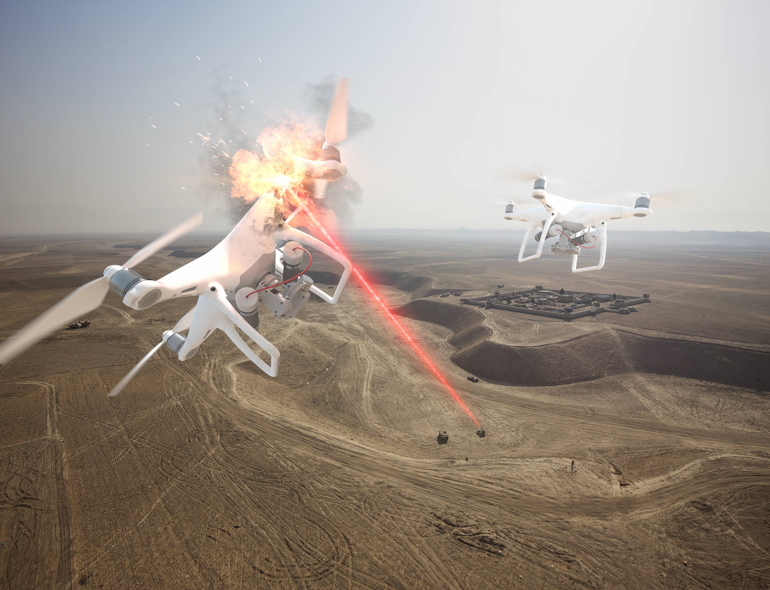
Among the most promising applications of early versions of today’s deployable laser weapons involves destroying or disabling enemy unmanned aerial vehicle (UAVs).
NASHUA, N.H. - When it comes to defending against oncoming missiles, laser weapons could provide a precise way to target and destroy from aboard a vehicle or ship. Laser weapons can defend against a mortar, which does not have a guidance system, or against a sophisticated drone. They travel at the speed of light and can be tuned to produce as little or as much damage deemed appropriate for the situation. In addition, they have a low capacity for collateral damage, since the size of the beam is so small and precise.
With all these capabilities, however, sometimes it seems that news of laser weapons has been played out. Since the 1960s, engineers and science fiction writers have debated the capabilities and uses of directed light. How many articles say something new is coming in the next five years — the same as they did five years ago? While we can’t say for sure whether laser weapons will change the game, the U.S. military — especially the Navy and Army — has poured time and money into lasers in the last year. So what’s the truth? Are laser weapons possible, or will they be forever just on the cusp of practical adoption?
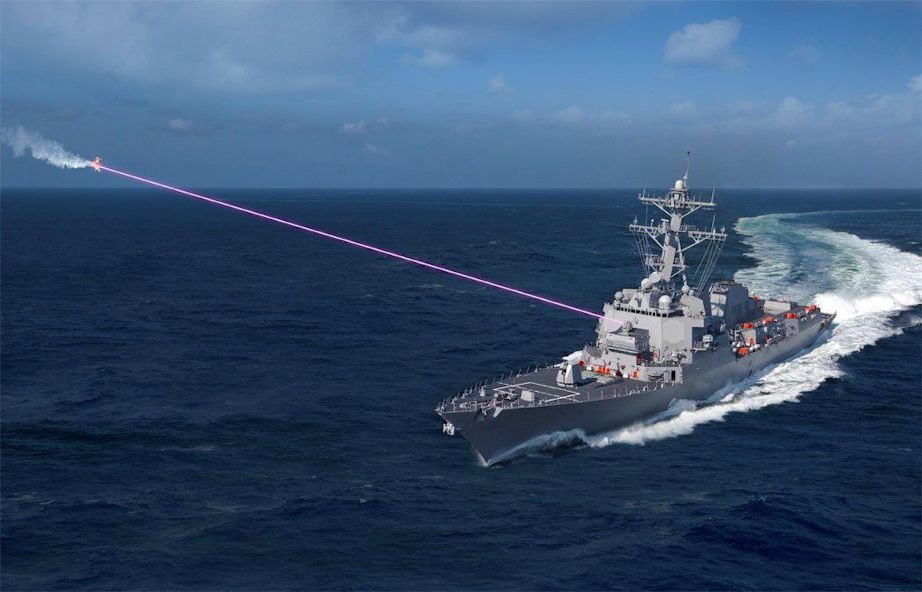
The U.S. Navy is set to complete installation of the High Energy Laser and Integrated Optical-dazzler and Surveillance (HELIOS) system aboard the destroyer USS Preble sometime this year.
U.S. Navy leaders today are beginning to deploy working lasers and figure out how to integrate them into existing military weapon systems. In November 2020 Rob Afzal, Lockheed Martin Corp. senior fellow of laser and sensor systems explained why, despite being around almost as long as rocketry itself, it has taken so long for today’s militaries to deploy laser weapons. “The issue, though, was that those systems were basically just too big, literally. They were physically too big to really be deployed in the tactical environment, on a truck or on an airplane, even on a ship, without taking up large portions of the ship.”
Now, that’s changing. In a test around this time last year the Navy used a solid state laser — technology maturation (SSL-TM) laser weapons system demonstrator (LWSD) MK 2 MOD 0 from the amphibious transport dock ship USS Portland (LPD 27) to shoot down an unmanned aerial vehicle (UAV) during tests.
So, what is the state of laser technology today? And has science fiction truly become reality, or is it still all talk and hopes? Where and by who are they currently deployed?
The U.S. Army, Air Force, and Navy all have applications and equipment for laser systems today. In 2020 Army leaders announced they will be testing 50-kilowatt lasers mounted on Stryker wheeled combat vehicles. Built by two subcontractors, Northrop Grumman Corp. and Raytheon Technologies Corp., and prime contractor Kord Technologies, these Directed Energy Maneuver Short-Range Air Defense systems, or DE M-SHORAD, will begin testing this summer.
The Navy’s littoral combat ship USS Little Rock has a 150-kilowatt laser weapon, likely Lockheed Martin’s $150 million High Energy Laser and Integrated Optical-dazzler and Surveillance (HELIOS), or the Surface Navy Laser Weapon System (SNLWS) Increment 1, making it the fourth Navy ship with such a system. This was a relatively easy meeting of ship and system, since both were made by Lockheed Martin.
While some of these laser weapons are offensive, others are dazzlers, made to confuse and blind sensors on other ships, aircraft, or flying missiles. These can burn out a vehicle’s cameras without pursuing an aggressive action. The guided missile destroyer USS Dewey, for example, has been fitted with a weapon that is known as ODIN, or Optical Dazzling Interdictor. This essentially blinds drones and causes them to crash. HELIOS can do both, combining dazzler capabilities with actual destruction.
There are some limitations as to what system can go on what ship, naturally. Not all ships can support the 150-kilowatt class systems. This is just one of the areas in which implementing laser weapons is a process in flux, as the Navy and other branches and manufacturers work on making integration with existing vehicles practical.
In a 2021 report, the Congressional Research Service named one of the use cases for lasers on ships as “potential combat situations against adversaries, such as China, that are armed with large numbers of missiles, including advanced models, and large numbers of UAVs.”
Lasers could solve two problems of combatting missiles and unmanned aircraft: restricted amounts of ammunition for surface-to-air missiles and Gatling guns, or unfavorable costs.
Since solid state lasers are powered by electricity, they could be fired indefinitely as long as the ship and the laser are operating properly. They also cost less and can defend against small boats and UAVs that might otherwise take from the pool of limited ammunition. Solid-state lasers ideally can counter fast-moving targets with precision, and offer the variability to be used for different responses from simply monitoring targets to causing major damage.
A brief history of high-energy lasers
The U.S. military has had electromagnetic spectrum weapons in mind since the 1960s. Throughout the 1980s, industry and military laid the groundwork for figuring out how to reach practical power levels, beam control and adaptive optics. The Department of Defense officially recognized lasers as a plausible future weapon in 1999, marking the beginning of formal research and development.
However, researchers did demonstrate limited-use lasers earlier than that, with the U.S. Defense Advanced Research Projects Agency (DARPA) firing a 100-kilowatt laser in 1968 and the Navy-ARPA Chemical Laser producing 250 kilowatts in 1975.
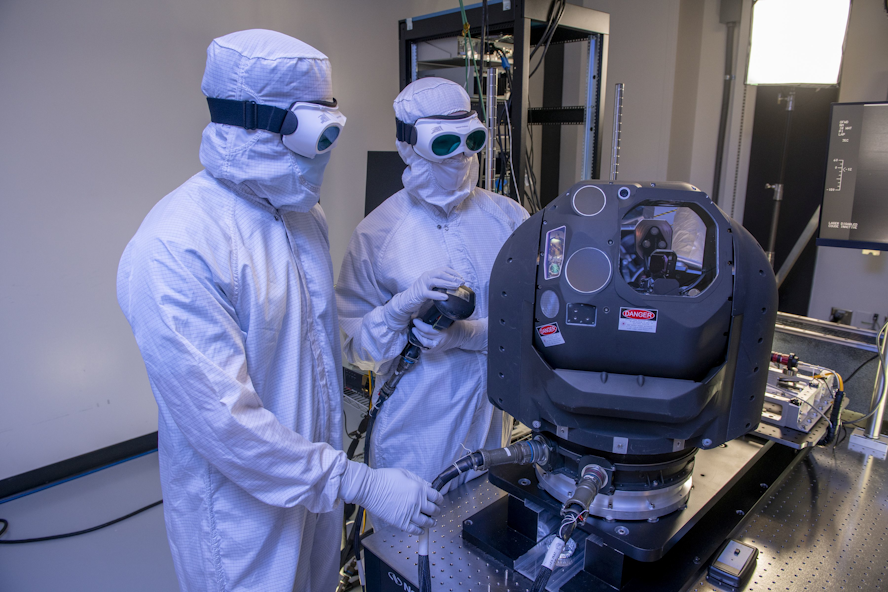
Raytheon has installed the prototype High Energy Laser Weapon System (HELWS) aboard a Polaris MRZR all-terrain vehicle to defend military forces from enemy unmanned aircraft.
Of course, to know what today’s lasers need when it comes to their onboard electronics, we need to know how a laser works in the first place. Technically a little-known acronym for “light amplification by stimulated emission of radiation,” lasers emit directed coherent light of a single wavelength.
When we refer to a solid-state laser, we’re specifying the source of power used to excite the photons that make up the beam. In a solid-state laser the tasing mechanism is a rod made up of a solid medium, such as glass, crystal or a gem, and an active material such as chromium, titanium or others. Alongside being weapons themselves, these are often the type of lasers used on range finders and target designators, since they can be made to fit in small spaces, are relatively inexpensive, and can run on batteries.
Today’s optical fiber lasers also are technically solid state, using optical fibers as the gain medium. They’re more rugged than older solid-state lasers, and don’t require a clean room to operate or be maintained.
The Navy’s first use of a prototype solid-state laser was in 2009, a laser weapon system which was tested against drones and had a reported beam power of 30 kilowatts. The amphibious transport dock ship USS Ponce carried an AN/SEQ-3 Laser Weapon System (LaWS) in August 2014 to test the system against swarming boats and swarming UAVs. At that time, it was considered “operational.” From there it was replaced with another ship and the LaWS removed to be refurbished as a test asset for the HELIOS system.
New Threats
New and different threats also make high-energy lasers more practical than they were before.
“High-energy laser systems are a better match to the threats we now face versus the threats 10 or 20 years ago,” says Iain McKinnie, director for science and technology at the Raytheon Intelligence & Space segment in McKinney, Texas. “A lot of low-end threats have become much more widely available, more proliferated and widely available. I’m thinking of class 1 or 2 drones that can be armed or used as targeting assets, but also rockets, artillery or mortars. Lasers are really well-suited to deal with threats not particularly hardened, not particularly difficult to kill from a laser standpoint. Also depending on how they’re operated they have a very large or infinite magazine.”
In the past. lasers have been considered to be a way to defend against ballistic missiles, McKinnie says. However, that’s still a difficult application and doesn’t take advantage of the large magazine.
SWAP problems and solutions
“What is ironic about the recent attempts is that although I think the technology demonstrators were successful, meaning the system could be put together, and could track, engage and put lethal influence on a target to negate it, the systems themselves are not of a tactically relevant size, weight and power,” says Lockheed Martin’s Afzal. Those systems couldn’t be packaged or integrated.
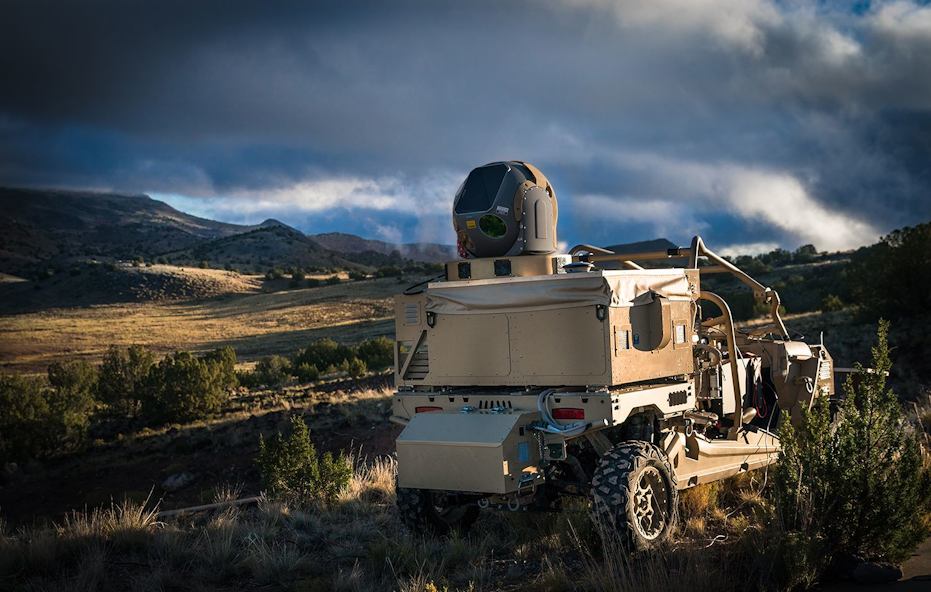
The U.S. Air Force has ordered High Energy Laser Weapon Systems (HELWS) for field testing to determine if the system can adequately defend against enemy drones.
But three things have changed. First, he says, the development of fiber laser technology has enabled the systems to be “the most efficient at converting electric power into a high-power beam, which means your electrical power systems and waste heat systems are minimized because efficiency is high.” Second, the beam is of high-quality. Third, the commercial industrial base now can provide many of the core components.
Lockheed Martin developed the ability to combine the output of a large number of individual fiber lasers instead of trying to build a bigger single beam, says Lockheed Martin’s Afzal.
Commercial influence
There are several ways that commercial laser technologies have influenced military laser weapons. Fiber-optics became widely used in communications, and fiber-laser cutters allowed for industrial cutting, welding, and drilling more cost-effectively. Building smart phones and other small electronic devices required very high beam quality from fiber laser cutters, meaning the beam could be focused very specifically.
The Congressional report says significant advancements in industrial solid-state lasers and military research have been critical to making advancements in this area. From there, defense use requires combining mutual individual fiber lasers using spectral beam combination. It reflects those fiber-laser channels off a gating that combines them into a single-output beam.
Along with the ability to focus the beam, a laser weapon needs to propagate at long distances for the different laser strands to remain tight. The beam director needs to stand up to the usual effects of a shipboard environment, where moisture and salt can damage equipment.
“One factor in driving down SWAP has been the development in the commercial domain of fiber lasers,” says Raytheon’s McKinnie. “First is the communications industry. Low-power fiber optics transmitting signals very often with a high data rates, the things that transmit all of our communications over the internet, a lot of our voice communication etc. since it was first brought about in the ‘80s perhaps — that’s continued to advance. There’s a very deep supplier base and a deep global industry in that area.”
The kind of signals required in communications are five or six orders of magnitude lower than those in defense uses. However, it’s still at the core an enabling technology.
Lockheed Martin’s Afzal says he agrees that fiber development in communications made a difference, as did industrial cutting, welding and drilling. The way the fiber is made, the purity of the material, the technique for doping fibers with rare earth elements, creating wave guides, and being able to pull fibers at large sizes and high quality all came from industry. Technology to make semiconductor diode lasers for telecom also comes into play in militarized lasers.
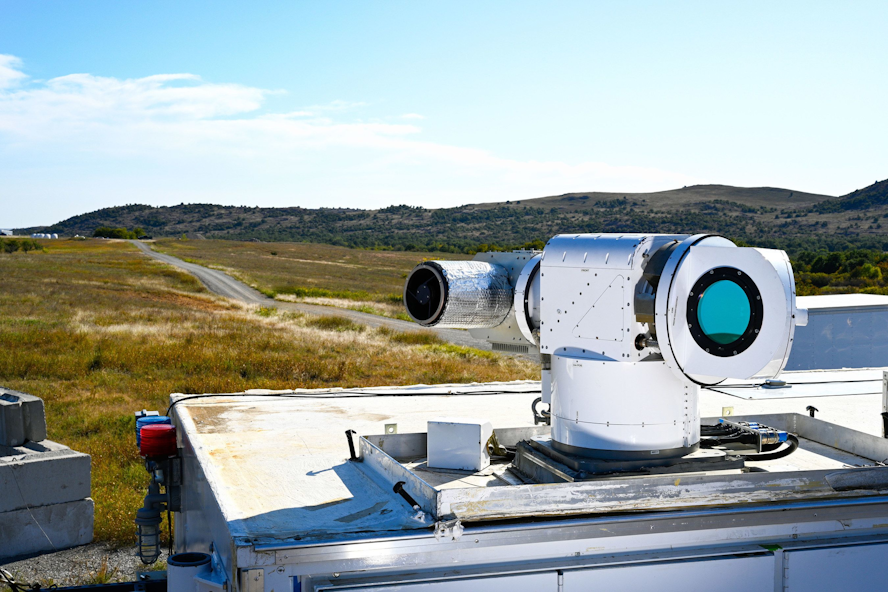
The Lockheed Martin Advanced Tactical High Energy Asset (ATHENA) is a prototype laser weapon system to defeat close-in, low-value threats such as improvised rockets, unmanned aerial systems, land vehicles, and small boats.
“The last piece is all the micro-optics, even in the low power domain, being able to make hardened components that are kind of the optical equivalent to electronic components like add/drop filters and MUXes and deMUXes,” Afzal says.
From the industrial welding side, directed-energy laser applications use technology including high efficiency electrical circuits, power switching circuits and the fiber itself which can hold up under such high-density power.
When it comes to tracking targets with a laser weapon, that requires processing of video from several high-speed cameras. The technology that enables this fast processing draws on developments in the video gaming industry.
“Using all these high-speed video game processors that can process that kind of data and that can do the visualization ... We can run our algorithms against those, and those are truly enabling,” says Lockheed Martin’s Afzal.
When asked about this element, Raytheon’s McKinnie had a slightly different take, saying faster processing is not necessarily a priority. Instead, he says he’s watching the artificial intelligence (AI) and machine learning sectors, which in the future could help with target selection and aiming.
Afzal says he also is watching the electrification industries; he says high-energy lasers are to bullets as high-capacity batteries are to internal-combustion engines. Some of the challenges the electric vehicle market faces, he says, ultimately could benefit high-energy laser weapons. Common to laser weapons and electrification are energy storage at high power, thermal management, the ability to deliver power efficiently, cables, power transmission, switching circuits, and other power-distribution technologies.
What’s next?
As Afzal says, “everybody likes to talk about scaling laser power.” Still, the challenge involves ensuring that long-range laser weapons can remain focused and at full power for short defeat times.
Raytheon tries to solve this with a product it already makes, called the multi spectral targeting system (MTS). It’s a turret used for targeting in a wide range of manned and unmanned aircraft today, and is already in volume production and thoroughly tested.
“The MTS’s real strength is very low jitter — an ability to point over a long range with very high precision,” says Raytheon’s McKinnie. “That’s very important for targeting and surveillance missions when you don’t have a laser involved, you just want to be able to keep looking at the same object but it’s also important for high-energy laser systems.
“High-energy laser systems don’t kill targets immediately; it’s essentially a heating effect, so it takes several seconds to kill a target, McKinnie continues. “During that several seconds it’s critical to hold the beam on the target. The beam spot might be centimeters in diameter, but if that is kilometers away its very easy for it to jitter around due to the motion of the target or the platform or the effects of the atmosphere.”
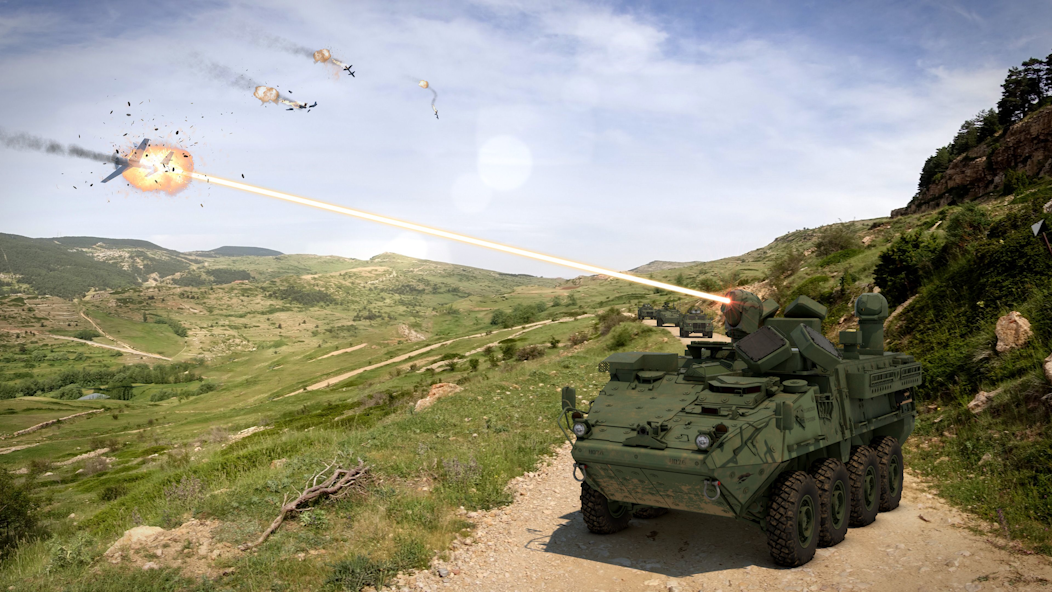
Army leaders would like to install a high-energy laser weapon on the Stryker eight-wheeled armored combat vehicle as part of the Initial Maneuver Short Range Air Defense (IM-SHORAD) program.
If the laser points precisely enough, it actually needs lower power levels to kill each target, McKinnie points out.
However, this still won’t solve the problem of weather. Adapting to different weather conditions, such as heat distortion, might be a problem. It’s the same phenomenon that in the heat can make cars in the distance look like they’re wavering on the wind or floating on water. Adaptive optics, or atmospheric compensation, is the next frontier for technology that can prevent these effects from dissipating some of the laser’s focus on the way to the target.
“Even the best beam in the world will jitter around due to scatter in the atmosphere,” Raytheon’s McKinnie says. “The way to address that challenge fully is what’s called adaptive optics, and that’s something that’s on our roadmap at Raytheon, but it’s also quite expensive and has never been made as robust as we need for deployment. So there’s some years ahead of us in adaptive optics to focus on those longer ranges. So we focus on shorter-range missions.”
The Congressional Research Service report outlined a few more problems that might make solid-state lasers a ‘fair-weather’ weapon: they work only over line of sight, can be adversely affected by atmospheric turbulence and an effect known as thermal blooming, which risks unintentional damage to aircraft, satellites, and surface ships. Cloud cover can render laser weapons inoperable.
The Navy reportedly plans to pursue 300-kilowatt weapons to interdict and destroy enemy cruise missiles. That requires lasers that can concentrate enough power with enough accuracy on the long side of an incoming missile, since the nose cones are already designed to survive very high heat.
Next, the Navy will attempt to reach the stepping stone of a 150-kilowatt laser beam. Companies such as BAE Systems, Northrop Grumman, Raytheon, and others competed for a 2015 spot eventually won by Northrop Grumman.
This system was fitted aboard the amphibious transport dock ship USS Portland in fall 2019. Fitting it required first choosing a vessel with the right space, weight, and power-generation capacity. The USS Portland was already had the right electrical cables for the laser.
Next, Navy experts will install HELIOS on a Burke-class destroyer USS Preble by sometime this year. Fleet testing and sustainment is scheduled through at least the end of 2025.
As with anything else, size, weight, and power consumption (SWaP) considerations are important. SWaP also is one of the barriers to installing laser systems at all, not even getting into the details of how electronics are packed inside the system itself. The U.S. military remains a far way from hand-held laser guns.
“If I’m going to burn the boats, I’m going to replace something that I have on ship today doing that mission with those weapons,” said Rear Adm. Ron Boxall, director of Navy Surface Warfare, in a March 2019 press report. “And if I do that, I’ve got to be confident that it’s going to work and it’s going to cover those missions.”
In particular he was talking about a directed-energy system on a Burke-class Flight IIA destroyer, and about how that weapon would integrate with other systems on the ship. He points out that it needs to coexist with the Aegis weapon system and its powerful radar, battle management, and anti-air missiles. Lockheed delivered the HELIOS to the Navy last January.
Lockheed Martin’s Afzal points to the HELIOS as a mark of how lasers are no longer theoretical. “It’s not going out as a prototype on a range; it’s going on a real ship. That should give you the indication that we’re at a very important tipping point and change point where it’s not about proving that the pieces can be put together and can work, it’s about building a weapon and integrating it onto a ship and tying it into the combat systems so it can be an effector like any other effector and not just a demonstration ... That’s why it’s not just going to go back to the lab.”
Raytheon’s McKinnie cautions that the cost of laser weapons still need to come down before they can be used in large numbers. But he points to the Air Force and Army Stryker applications as leaps toward actually putting this in the field.
“We’ll learn so much from the way they use them and don’t use them versus working in the lab for the next three or five years,” says McKinnie.
Last edited:
Laser weapons for fighter jets are being tested in USAF wind tunnels
4 AUGUST 2021
Michael Tyrrell
Direct energy weapons in development for the US Air Force's fighter jet fleet are currently going through wind tunnel testing.
DE systems, which use high-energy lasers or microwaves to degrade or destroy targets, can be affected by an aircraft’s shockwaves in the air, affecting beam quality and effectiveness of the laser.
Now the Aerodynamics Branch of Arnold Engineering Development Complex at Arnold Air Force Base in the US is putting this to test in wind tunnels.
“There is a growing interest for directed energy systems within the DOD [Department of Defense] for many purposes, especially defending our systems and personnel,” said Rich Roberts, chief of the Aerodynamics Branch Store Separation Section. “There are a number of systems in use and being developed across the DOD. Integrating the DE systems on aircraft has obvious benefits but also creates challenges, especially at higher speeds.”
Wind tunnel testing allows test engineers to visualise and measure changes to the airflow while controlling variables such as Mach number and altitude pressure.
A DE test conducted recently in the 4ft transonic wind tunnel, or 4T, is the culmination of approximately eight years of work. AEDC engineers have worked with MZA Associates Corp through Small Business Innovative Research, or SBIR, and Commercial Readiness projects to develop the Aero Isolation Measurement System, or AIMS, to enable aero-optical DE testing in the wind tunnels.
“Simply put, this system transmits a laser to the model, uses a miniaturized optical bench of sorts inside the model, then uses fibre optics to pipe the data to a wave front sensor system,” Roberts said. “From there, we can analyse data that tells us how the laser was impacted by the tunnel flow field around the model.”
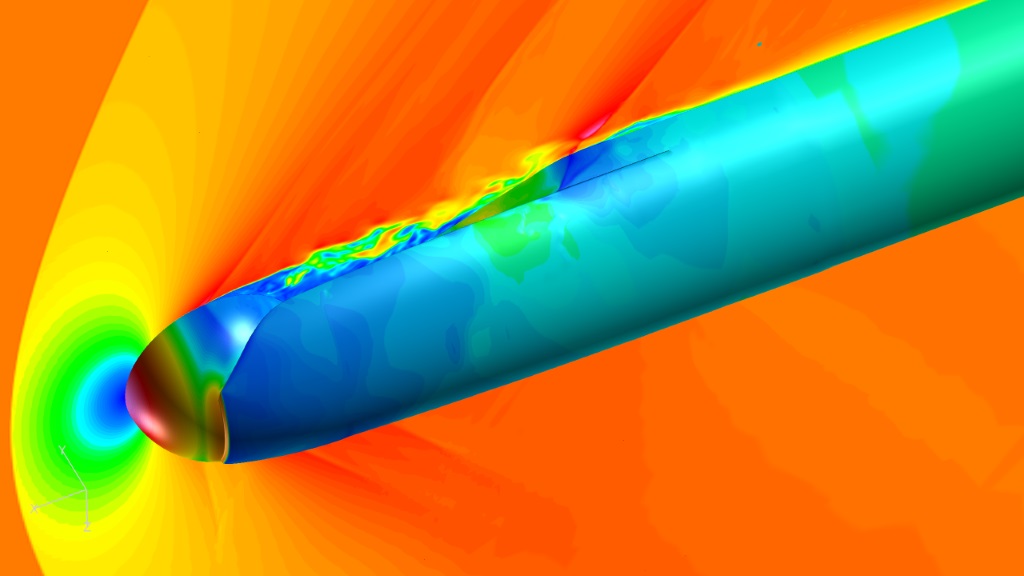
Computational fluid dynamics simulations for the directed energy pod show pressure loading on the pod and flow features off-body for supersonic conditions
MZA was also the customer for the recent test. The company has been working with the Defense Advanced Research Projects Agency on a supersonic aero-mitigation project with the goal of lessening the impact of high-speed flow over a turret. A prototype of a flow mitigation fence was tested in 4T.
“We are looking at how well this design controls the air flow over the turret to minimize the impact moving air has on the performance of the system,” Roberts said. “We are also comparing tunnel test data to previously generated CFD [computational fluid dynamics] data to make sure the simulations properly represent actual data. This test in 4T was the first time that this system has been experimentally tested at supersonic conditions, in addition to the first time that the AIMS system has been used at AEDC. The test went very well, getting all the priority data over two days of testing. An initial look at the data shows a significant improvement in beam quality using this new aerodynamic fence design.”
Building on this new capability, AEDC is working through a SBIR project to develop the Integrated Directed Energy Aero-Optical Surrogate, or IDEAS, which is a subscale model of an F-15 aircraft with the ability to test laser pods. The IDEAS hardware is scheduled to undergo acceptance testing later this year.
“The ability to perform aero-optical tests of directed energy systems in the wind tunnels represents a new test capability for AEDC,” Roberts said. “As more DE systems are developed and integrated onto aircraft, we’ll be able to help with design decisions, creating employment envelopes, defining adjacent weapons load outs and other things routinely needed by program offices and manufacturers.”
Army advances first laser weapon through Combat Shoot-Off
August 10, 2021
By Nancy Jones-Bonbrest,
Army Rapid Capabilities and Critical Technologies Office
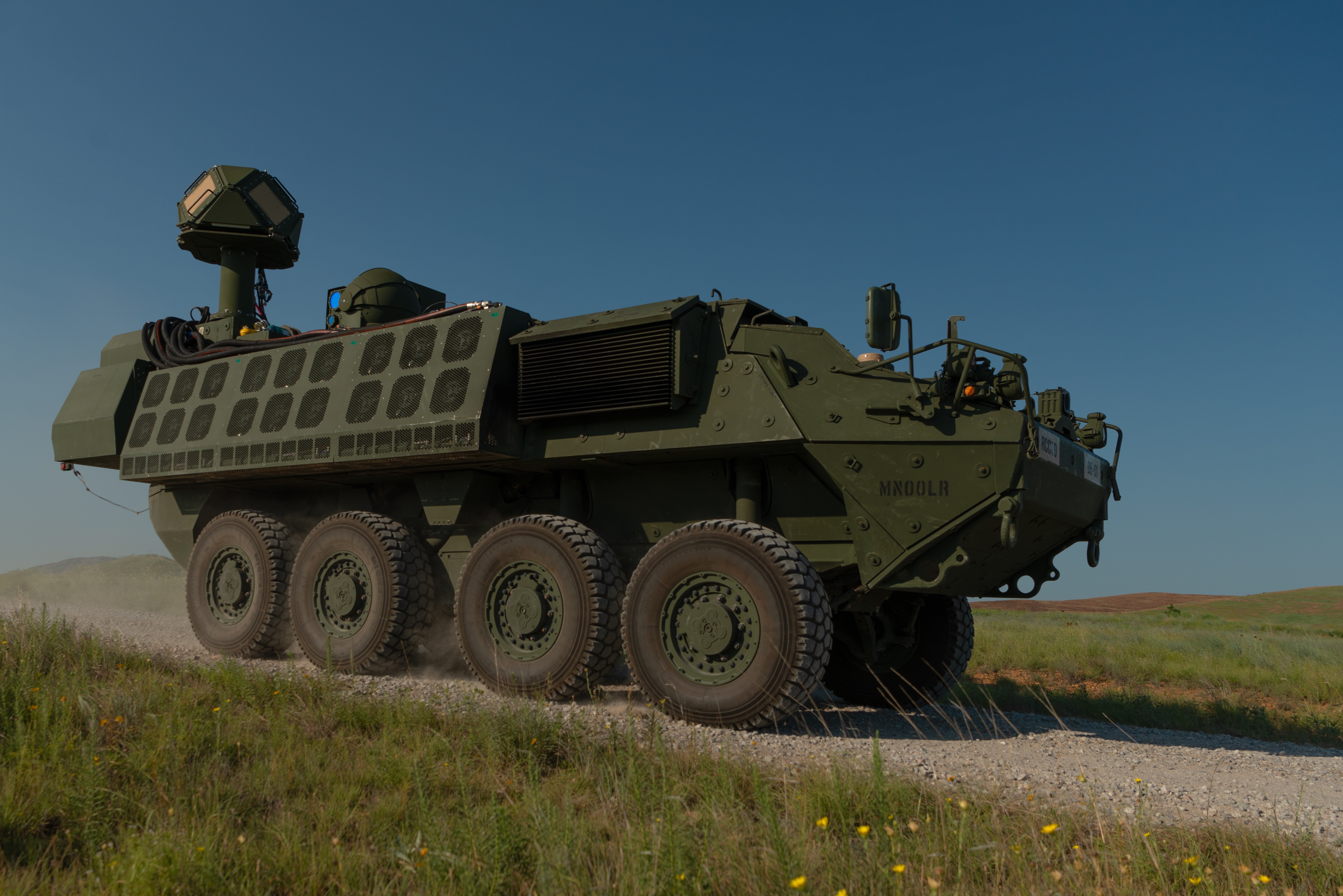
Intended to help protect Divisions and Brigade Combat Teams from UAS and RAM threats, the RCCTO is delivering a platoon of four laser-equipped Strykers by Fiscal Year 2022. The DE M-SHORAD Combat Shoot-Off took place in Fort Sill, Okla. this summer. (Photo by U.S. Army) (Jim Kendall)
FORT SILL, Okla. — As a leader in new and emerging technology, the Army is fielding next-generation capabilities to advance its Multi-Domain Operations and create standoff.
Nowhere is that more evident than with Directed Energy, where in 24 months, the Army harnessed the promise of lasers, integrated it onto a platform, and produced its first combat capable prototype.
Offering lethality against unmanned aircraft systems (UAS) and rockets, artillery and mortars (RAM), laser weapons now increase Army air and missile defense capability while reducing total system lifecycle cost through reduced logistical demand.
This summer, the Army Rapid Capabilities and Critical Technologies Office (RCCTO), alongside Air and Missile Defense Cross Functional Team, Fires Center of Excellence, and the U.S. Army Test and Evaluation Command, took the laser-equipped Stryker to Fort Sill, Okla. as part of its Directed Energy-Maneuver Short-Range Air Defense (DE M-SHORAD) Combat Shoot-Off. Intended to help protect Divisions and Brigade Combat Teams from UAS and RAM threats, the RCCTO is delivering a platoon of four laser-equipped Strykers by Fiscal Year 2022.
“This is the first combat application of lasers for a maneuver element in the Army,” said LTG L. Neil Thurgood, Director for Hypersonics, Directed Energy, Space and Rapid Acquisition, which includes the RCCTO. “The technology we have today is ready. This is a gateway to the future.”
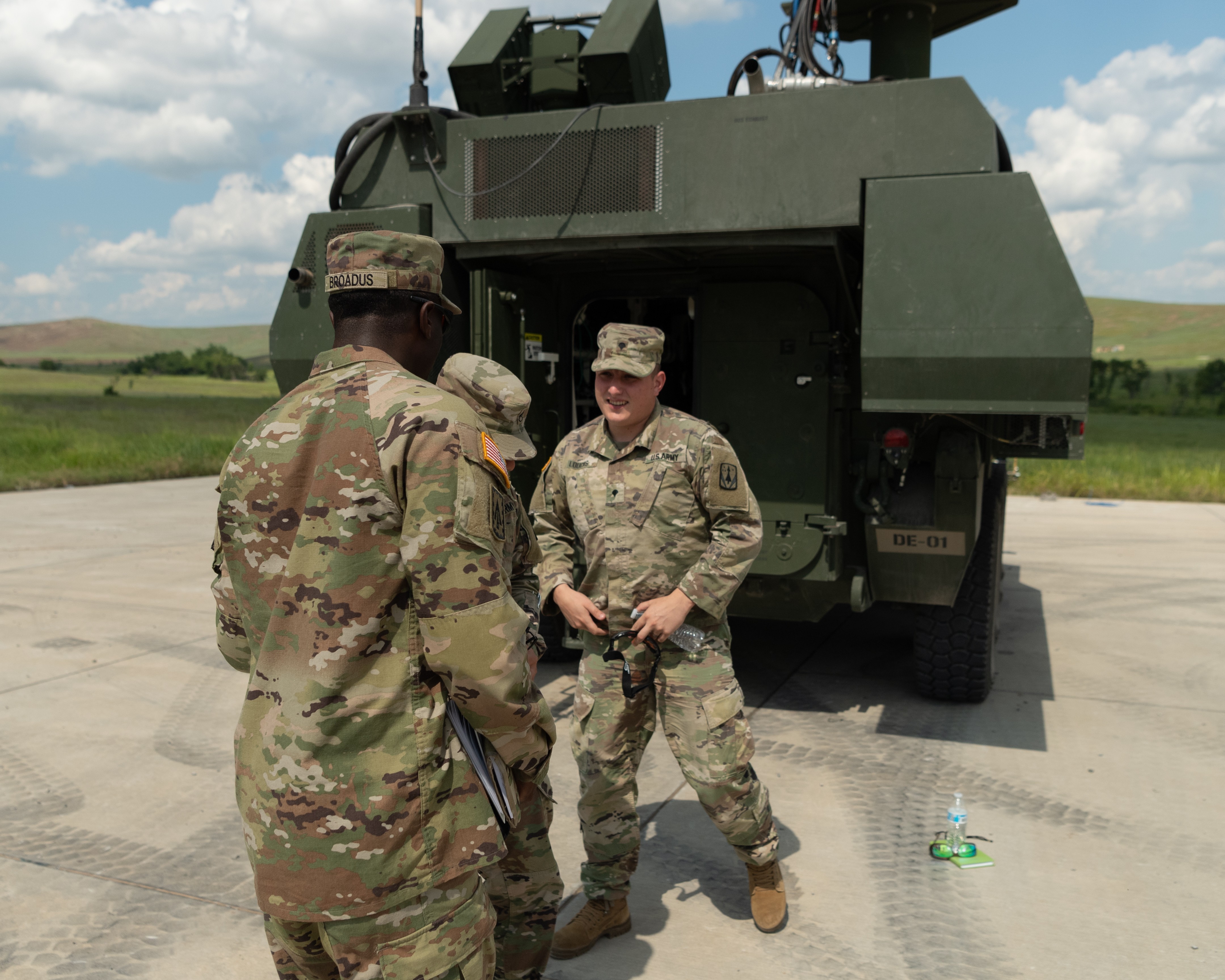
At the Combat Shoot-Off, the Stryker faced a number of realistic scenarios designed to establish, for the first time in the Army, the desired characteristics for future DE M-SHORAD systems.
“This has been an effort like no other,” said COL G. Scott McLeod, the RCCTO program manager for DE M-SHORAD. “We are building and delivering a brand new capability. This is not a modification or an upgrade. It took just 24 months for the combined government and industry team to design, integrate, and have it ready to perform in an operational environment.”
The DE M-SHORAD prototyping effort is part of the Army’s larger modernization strategy for air and missile defense. The Combat Shoot-Off, which ended in late July, trained Soldiers to operate the new defensive weapon, utilizing state-of-the-art immersive technology to quickly familiarize them with the DE M-SHORAD system. Within days, they were operating the system, demonstrating proficiency in target acquisition, aim point selection, and engagements.
Soldier centered design, embedded throughout the prototyping effort, surfaced in unique ways. For example, when it came time to train, Soldiers operating the system suggested using commercial gaming controllers as an improvement over the standard controller. They utilized three-dimensional models of the Strykers on a handheld device so they could virtually walk through the system in x-ray mode to dissect the parts and pieces. This instruction also offered online access to the system’s training manuals, measurements and dimensions, and interactive modules.
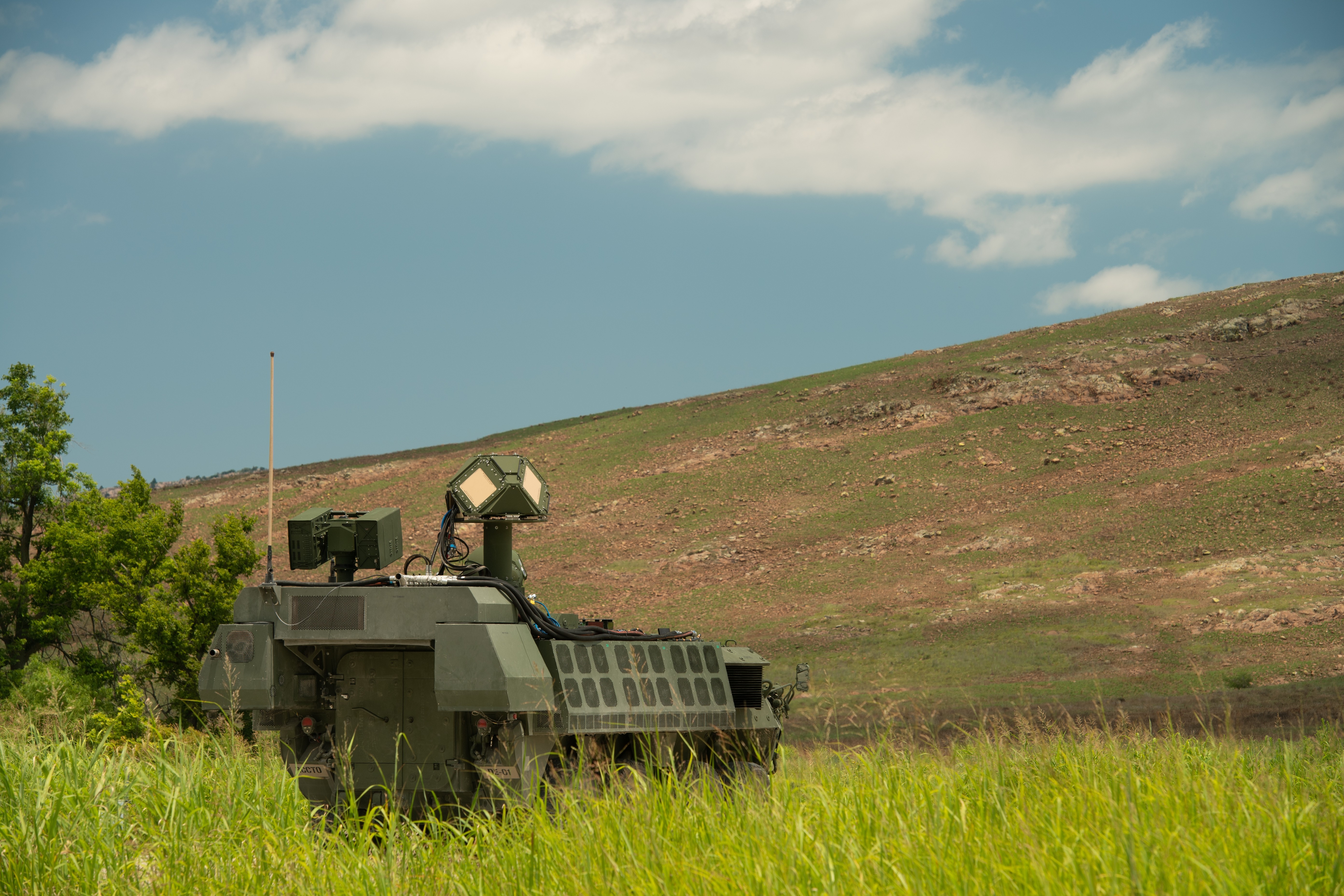
The Combat Shoot-Off culminated with Soldiers executing a series of vignettes designed to emulate realistic threats and combat scenarios. The DE M-SHORAD weapon system demonstrated the design characteristics and performance criteria established for the program, representing a major step in prototype completion in time for a fielding in FY22.
“This event marked a key milestone and is a great example of rapid prototyping,” said Dr. Craig Robin, deputy director of the RCCTO’s DE Project Office. “For the first time, we had a combat capable laser out on the range performing against realistic threats. We know it is not going to be perfect, but we will continue to work with Soldiers to incorporate their feedback and lessons learned from this assessment into the design to help inform future directed energy systems.”
To address the support and infrastructure around the prototype lasers, the RCCTO utilizes a unique stakeholder forum known as the Octagon. This integrated group of stakeholders includes representation from all aspects of Doctrine, Organization, Training, Materiel, Leadership, Personnel, Facilities, and Policy. The group works in parallel with prototype development, ensuring the right elements are ready when the prototypes are delivered.
“This is a prototype and we are going to learn from this,” Thurgood said. “We needed this to do two things: design it so it is safe enough to give to Soldiers and make sure it engages with the target it needed to. The science project in this technology is over. It’s time to give our Soldiers this first-ever operational capability.”
US Department of Defense
Contracts For Aug. 18, 2021
DEFENSE LOGISTICS AGENCY
Science Applications International Corp., Fairfield, New Jersey, has been awarded a maximum $99,000,000 firm-fixed-price, indefinite-delivery/indefinite-quantity contract for facilities maintenance, repair and operations supplies. This was a sole-source acquisition using justification 10 U.S. Code 2304 (c)(1), as stated in Federal Acquisition Regulation 6.302-1. This is a 450-day bridge contract with no option periods. Locations of performance are New Jersey, California, Utah, Arizona and Nevada, with a Nov. 11, 2022, ordering period end date. Using customers are Army, Navy, Air Force, Marine Corps and Coast Guard. Type of appropriation is fiscal 2021 through 2023 defense working capital funds. The contracting activity is the Defense Logistics Agency Troop Support, Philadelphia, Pennsylvania (SPE8E3-21-D-0011).
SupplyCore Inc.,* Rockford, Illinois, has been awarded a maximum $90,000,000 firm-fixed-price, indefinite-delivery/indefinite-quantity contract for facilities maintenance, repair and operations supplies. This was a sole-source acquisition using justification 10 U.S. Code 2304 (c)(1), as stated in Federal Acquisition Regulation 6.302-1. This is a 450-day bridge contract with no option periods. Locations of performance are California and Illinois, with a Nov. 11, 2022, ordering period end date. Using customers are Army, Navy, Air Force, Marine Corps and Coast Guard. Type of appropriation is fiscal 2021 through 2023 defense working capital funds. The contracting activity is the Defense Logistics Agency Troop Support, Philadelphia, Pennsylvania (SPE8E3-21-D-0012).
ARMY
Northwind Portage Inc.,* Idaho Falls, Idaho, was awarded an $82,175,322 hybrid (cost-plus-fixed-fee and firm-fixed-price) contract to remediate contaminated soils, sediment, fill, and debris. Bids were solicited via the internet with four received. Work will be performed in Luckey, Ohio, with an estimated completion date of Oct. 10, 2024. Fiscal 2020 and 2021 Formerly Utilized Sites Remedial Action Program funds in the amount of $62,200,327 were obligated at the time of the award. U.S. Army Corps of Engineers, Buffalo, New York, is the contracting activity (W912P4-21-C-0014).
Daycraft Systems,* Phoenix, Arizona, was awarded a $16,417,214 firm-fixed-price contract for commercially available firearms and training to satisfy Foreign Military Sales (FMS) requirements. Bids were solicited via the internet with one received. Work will be performed in Phoenix, Arizona, with an estimated completion date of Feb. 18, 2022. Fiscal 2021 FMS (Mexico) funds in the amount of $16,417,214 were obligated at the time of the award. U.S. Army Contracting Command, Newark, New Jersey, is the contracting activity (W15QKN-21-C-0060).
NAVY
Caddell-Nan JV, Montgomery, Alabama, was awarded a $36,571,666 firm-fixed-price task order (N6274221F9933) under a multiple award construction contract for the design and construction of a high-bay warehouse at Marine Corps Base (MCB) Guam. The task order also contains one unexercised option, which if exercised would increase cumulative task order value to $38,314,666. Work will be performed in Finegayan, Guam, and is to be completed by November 2023. The work to be performed provides for the design and construction of a base warehouse to serve MCB Guam. The warehouse will provide storage and administrative space to support the distribution management office, base supply, food services, and general services administrative daily operations. The option, if exercised, provides for the furniture, fixtures, and equipment. Fiscal 2021 military construction (Navy) contract funds in the amount of $36,571,666 are obligated on this award and will not expire at the end of the current fiscal year. Four proposals were received for this task order. The Naval Facilities Engineering Systems Command, Pacific, Joint Base Pearl Harbor-Hickam, Hawaii, is the contracting activity (N62742-19-D-1329). (Awarded Aug. 16, 2021)
American Petroleum Tankers LLC, Blue Bell, Pennsylvania, is awarded a $27,010,000 option (P00005) for the fixed-price portion of a previously awarded firm, fixed-price contract (N3220520C4105) with reimbursable elements to exercise a one-year option period to support the Defense Logistics Agency (DLA) and provide ocean going transportation to meet the Department of Defense’s (DOD) bulk fuel movement requirements. The M/V Empire State will provide worldwide support to assist DOD and DLA in meeting its need for global transportation of petroleum products. This contract includes a one-year-firm period of the performance, three one-year option periods and one 11-month option period, which if exercised would bring the cumulative value of this contract to $136,560,500. Work will be performed worldwide and is expected to be completed, if all options are exercised, by July 23, 2025. Working capital funds (transportation) in the amount of $27,010,000 are obligated for fiscal 2021 and fiscal 2022, and will not expire at the end of the fiscal year. This procurement was released under full and open competition, with an unlimited number of companies solicited via the beta.sam.gov website and two offers were received. The Navy’s Military Sealift Command, Norfolk, Virginia, is the contracting activity.
MZA Associates Corp.,* Albuquerque, New Mexico, is awarded an $18,697,835 cost-plus-fixed-fee contract for the counter unmanned aerial vehicle (C-UAS) High Energy Laser Weapon System (HELWS). The contractor will design, develop, deliver, integrate, test and demonstrate a compact, portable, low-cost and reliable C-UAS HELWS using the latest available commercial components. Work will be performed in Albuquerque, New Mexico (80%); and Dayton, Ohio (20%). Work is expected to be completed by Aug. 17, 2023, and if all options are exercised, will continue until Aug. 17, 2025. Fiscal 2020 research, development, test and evaluation (Navy) funds in the amount of $9,297,835 are obligated at time of award and will expire at the end of the current fiscal year. This contract was competitively procured under N00014-21-S-B001, “Long Range Broad Agency Announcement (BAA) for Navy and Marine Corps Science & Technology.” Since proposals are received throughout the year under the long range BAA, the number of proposals received in response to the solicitation is unknown. The Office of Naval Research, Arlington, Virginia, is the contracting activity (N00014-21-C-1116).
Vertex Aerospace LLC, Madison, Mississippi, is awarded a $9,918,884 modification (P00008) to a previously awarded firm-fixed-price contract (N0001917C0080). This modification exercises an option to provide organizational and intermediate depot maintenance, logistics and supply support for three KC-130J aircraft for the government of Kuwait. Additionally, this modification provides limited repair of common support equipment. Work will be performed in Abdullah Al-Mubarak Air Base, Kuwait, and is expected to be completed in August 2022. Foreign Military Sales funds in the amount of $9,918,884 will be obligated at time of award, none of which will expire at the end of the current fiscal year. The Naval Air Systems Command, Patuxent River, Maryland, is the contracting activity.
CH2M Hill Constructors Inc., Englewood, Colorado, is awarded a $9,343,200 modification for exercise of two options on a firm-fixed-price task order under a multiple award construction contract for design build hurricane recovery work at Naval Air Station Pensacola. After award of this modification, the total task order value will be $24,337,800. Work will be performed in Pensacola, Florida, and is expected to be completed by December 2023. The work to be performed provides for design build Hurricane Sally recovery work for repairs for NAS Pensacola Buildings 3902 and 3903. Fiscal 2021 operation and maintenance (Navy) contract funds in the amount of $9,343,200 are obligated on this modification and will expire at the end of the current fiscal year. The Naval Facilities Engineering Systems Command Southeast, Jacksonville, Florida, is the contracting activity (N62470-19-D-8024).
AIR FORCE
The Boeing Co., St. Louis, Missouri, was awarded a $9,987,543 modification (P00001) to previously awarded contract FA8621-21-C-0001 for F-15C and F-15E Mission Training Centers (MTC). The contract modification provides for updates to the F-15 MTC training systems in order to achieve training service objectives. The locations of performance are Mountain Home Air Force Base, Idaho; Seymour Johnson AFB, North Carolina; Nellis AFB, Nevada; Kadena Air Base, Japan; and RAF Lakenheath, Suffolk, England. Fiscal 2021 Air Force 3400 operation and maintenance funds in the amount of $9,987,543 were obligated at the time of award. The contracting activity is the Air Force Life Cycle Management Center, Wright Patterson AFB, Ohio.
KBRwyle Technology Solutions LLC, Columbia, Maryland, has been awarded a $9,657,329 task order for refurbishment and upgrades to eight Eddy Current Inspection Systems (ECIS). This contract provides for enhancements to hardware and software for eight robotic ECIS, to include new bases, robotic arms, computers and station executive software. The location of performance is Dayton, Ohio, and work is expected to be completed by Dec. 31, 2025. This award is the result of a sole-source acquisition; one solicitation was sent and one proposal was received. Fiscal 2021 4930 working capital funds in the amount of $9,657,329 are being obligated at the time of award. Air Force Sustainment Center, Maintenance Contracting Branch, Tinker Air Force Base, Oklahoma, is the contracting activity (FA813221F0062).
*Small business
£72.5-million investment for laser and radio frequency weapons
14 September 2021
Ministry of Defence and Defence Science and Technology Laboratory
Three contracts awarded to produce new Directed Energy Weapons advanced demonstrators for British Army vehicles and Royal Navy frigate
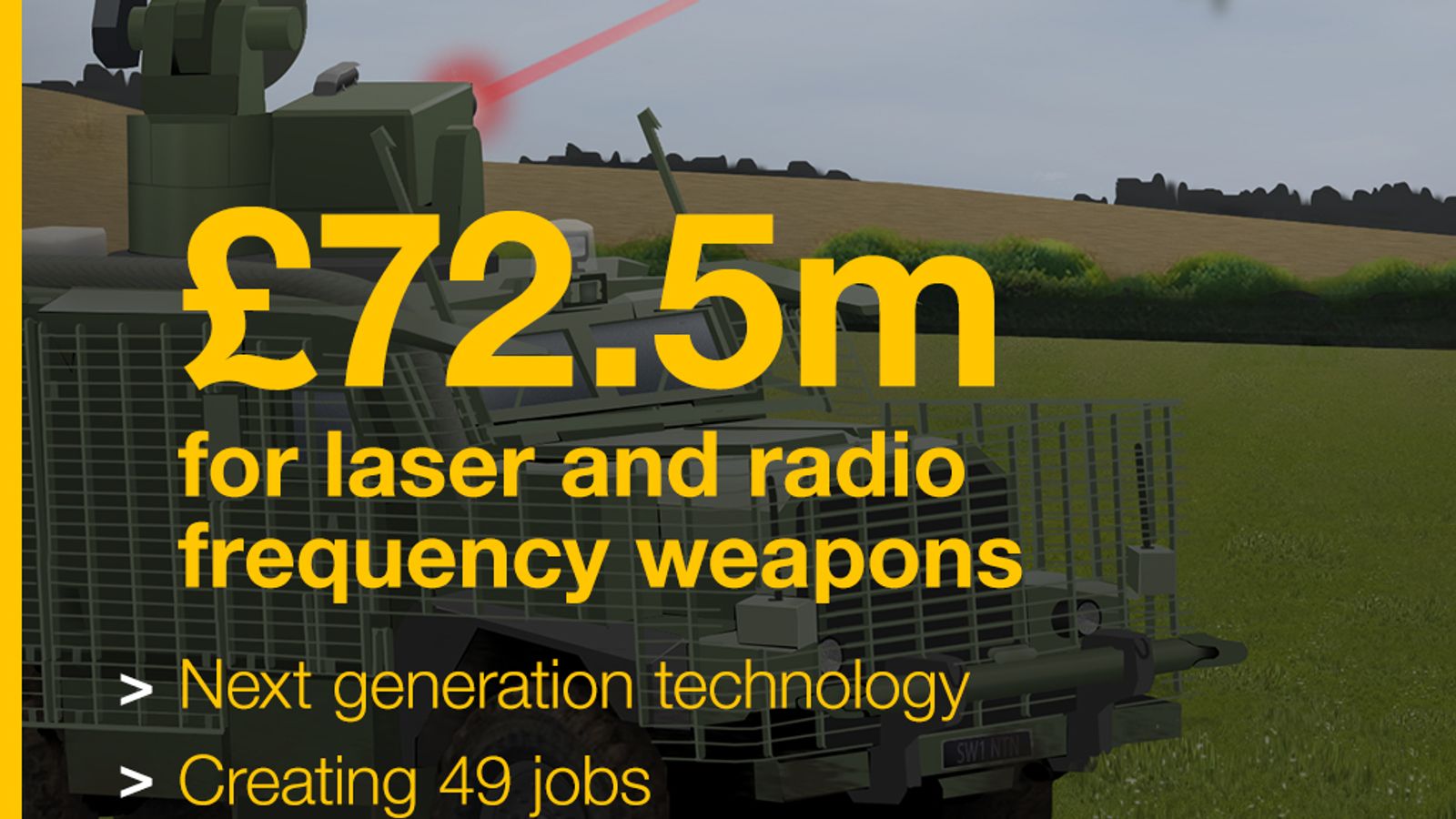

The MOD has awarded three contracts worth around £72.5-million to UK industry to produce advanced laser and radio frequency demonstrators as part of the Novel Weapons Programme (NWP).
Known collectively as Directed Energy Weapons (DEW), these next-generation technologies could revolutionise the battlefield and reduce the risk of collateral damage. The systems are powered by electricity and operate without ammunition, significantly reducing operating costs, increasing platform endurance and providing unprecedented offensive and defensive flexibility to personnel on the frontline.
Awarded to consortia headed by Thales and Raytheon UK, the four-year contracts will create at least 49 new jobs and sustain 249 jobs.
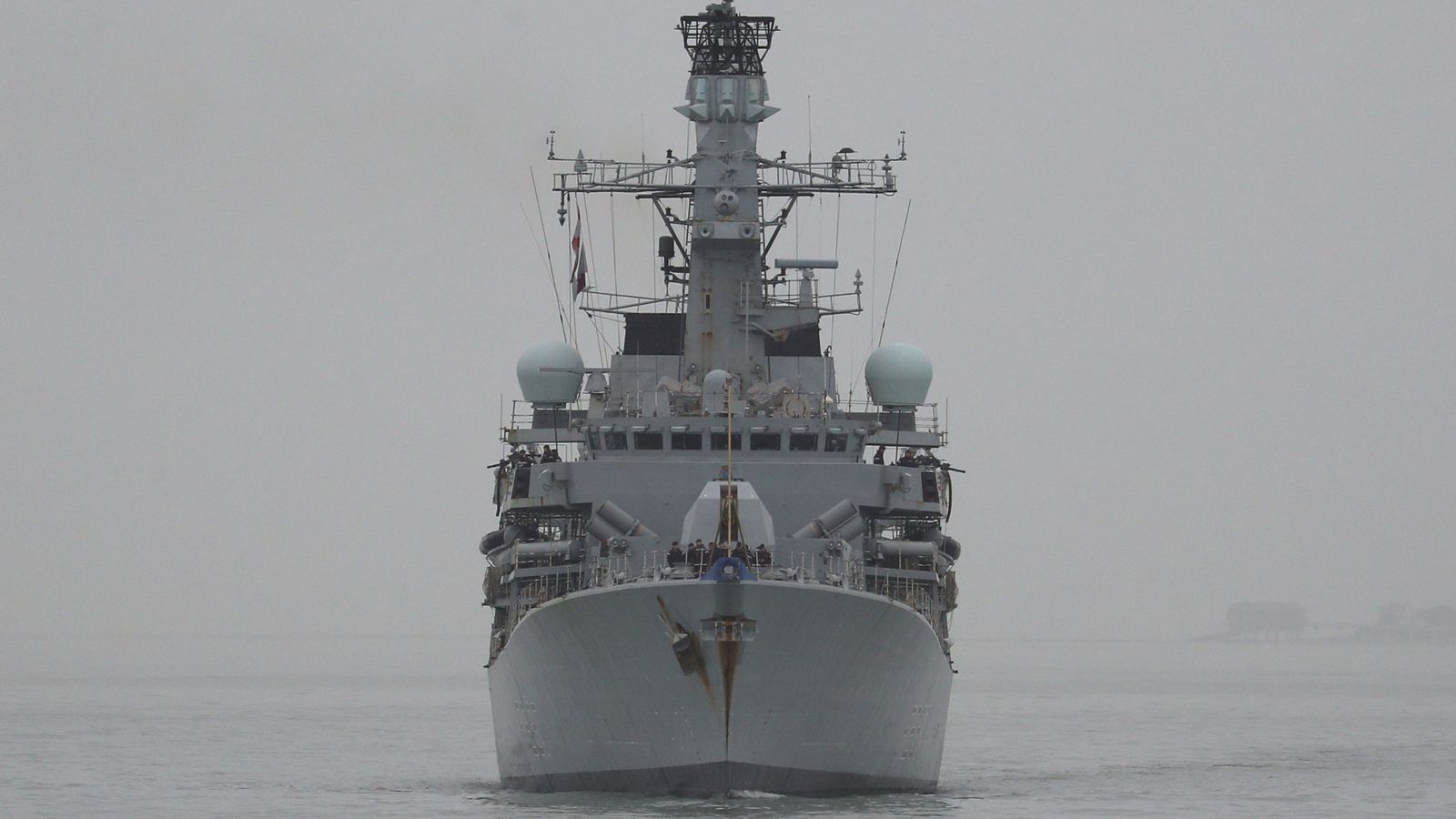
The first laser will be put on board a Royal Navy Type 23 frigate. File pic
The first laser will undergo user testing onboard a Royal Navy Type 23 frigate by detecting, tracking, engaging and countering Unmanned Aerial Vehicles (UAV), whilst the British Army’s Wolfhound armoured vehicle will host a laser demonstrator that will investigate capability against UAV and other air threats. The radio frequency demonstrator will also be used by the British Army, hosted on a MAN SV truck to detect and track a variety of air, land and sea targets. This will create around 30 new jobs at Thales in Belfast, Northern Ireland.
Minister for Defence Procurement, Jeremy Quin, said:
“We are investing £6.6-billion in research and development across Defence over the next four years, reaffirming our commitment to provide the Armed Forces with truly advanced capabilities.“Directed Energy Weapons are a key element of our future equipment programmes and we intend to become a world-leader in the research, manufacture and implementation of this next-generation technology.”
Marking a significant step towards the use of high-powered laser and radio frequency weapons across Defence, the investment reaffirms commitments outlined in the Defence Command Paper ensuring UK Armed Forces are equipped with the best possible equipment ready to deal with new and emerging threats.
Further supported by an increase of £24-billion of Defence spending over the next four years and an additional £6.6 billion of funding for research and development, this a prime example of how the MOD is using research partnerships with industry to invest in the technology of tomorrow.
These innovative capabilities will be integrated onto existing platforms for the Royal Navy and British Army and will undergo user experimentation from 2023 to 2025. The experimentation will focus on operation and maintenance of these new systems and will provide invaluable knowledge, information and experience to assess whether DEW can be fully embedded on other Defence assets in the future.
MOD Director Strategic Programmes, Shimon Fhima said:
“These technologies have the potential to revolutionise the future battlefield for our Armed Forces, enabling the prosecution of new targets in the land, sea and air domains and allowing commanders to meet mission objectives in new ways.“We must exploit at pace the cutting-edge technologies developed by the talented scientists and engineers across the UK to capitalise on its benefit.”
The newly formed Team Hersa brings together the best acquisition skills from Defence Equipment and Support (DE&S) and the best in technical expertise from the Defence Science and Technology Laboratory (Dstl).
Team Hersa will manage delivery of the demonstrators and is responsible for preparing Defence for the introduction of innovative weapons systems, ensuring the UK Armed Forces can successfully integrate the weapons on current aircraft, ships and vehicles.
The new contracts will exploit decades of MOD experience developing cutting-edge laser and radio frequency weapons technology and globally recognised strengths in performance testing and evaluation of these systems.
Microwave Weapons: Are they the Future or a Costly Disaster?
September 30, 2021
Michael Peck
Microwave weapons can be as dangerous to the user as to the target.
Here's What You Need to Remember: "No matter how well we may shield the cabin, this electronic pulse will get through. And as a human is also, to some extent, a ‘device’ operating on the basis of receiving and transmitting electromagnetic signals, such weapons can cause heavy damage to the health of the pilot."
Russia will arm its sixth-generation combat drones with microwave weapons.
These weapons, which disable an aircraft’s electronic equipment, already exist today “and can hit targets within a radius of tens of kilometers,” said Vladimir Mikheev, a director of state-owned Russian electronics firm KRET, in an interview with TASS.
However, Mikheev suggested that microwave weapons can be as dangerous to the user as to the target. While Russia is developing manned and unmanned sixth-generation aircraft, which are predicted to first take flight in 2025, only the unmanned version will be armed with a microwave weapon. “The electromagnetic pulse fired by the microwave weapon is so powerful that it is extremely difficult to protect the pilot from his own weapons,” Mikheev said. “No matter how well we may shield the cabin, this electronic pulse will get through. And as a human is also, to some extent, a ‘device’ operating on the basis of receiving and transmitting electromagnetic signals, such weapons can cause heavy damage to the health of the pilot.”
“Protection is already in place today: shielding, special goggles and a glass canopy covered with gold plating to reduce radiation. However, it is so far impossible to ensure 100 percent protection.”
Echoing the same debates in the United States over manned versus unmanned combat aircraft, Mikheev said that only the unmanned version of Russia's sixth-generation aircraft will have “full technical capabilities.” He predicted these drones will be hypersonic, with a speed of Mach 4 to 5, and will be capable of flight through near space (sixty-five thousand to 328,000 feet).
Mikheev also notes that that fifth-generation aircraft, such as the F-22, F-35 and Russia’s PAK FA, are characterized by supersonic cruising speed and stealth designs. But what will distinguish sixth-generation aircraft from their predecessors is the capability to work with drones. Mikheev offered a vision of Russian drone warfare that sounds much like its American counterpart. Like the United States, Russia is embracing manned-unmanned teaming, where piloted aircraft control packs of drones.
Also like American defense contractors, Russian companies say price shouldn’t be a barrier to capability. While drones are cheaper than manned aircraft, they will never be cheap. “They will come at a serious price, given that it will be a high-tech weapon—an aircraft combining hypersonic flight speed, low visibility, high security, artificial intelligence (in order to work in a group) and the most modern weapons, including electromagnetic. The sixth-generation arsenal will also include the latest weapon control systems, reconnaissance, electronic warfare, guidance, navigation and Identification Friend or Foe.”
The U.S. military is also grappling with what a sixth-generation combat aircraft will look like. Long range, stealth and supersonic cruising capabilities are likely to be features, as will be non-kinetic armament such as microwave or other electromagnetic weapons. It is a certainty that the next generation of manned aircraft will only be a component of a larger team, with the pilot the would-be master of a swarm of drones increasingly capable of autonomous flight.
The ultimate question: Will a sixth-generation aircraft even have a pilot?
Lockheed Martin Delivers High Energy Laser To U.S. Air Force For Flight Testing On AC-130J Aircraft
October 6, 2021
BOTHELL, WASH
Company completes critical testing; delivers and receives support contract for the Airborne High Energy Laser (AHEL)
Lockheed Martin (NYSE: LMT) successfully completed factory acceptance testing for the Airborne High Energy Laser (AHEL), in preparation for U.S. military ground and flight testing of the system.
“Completion of this milestone is a tremendous accomplishment for our customer,” said Rick Cordaro, vice president, Lockheed Martin Advanced Product Solutions. “These mission success milestones are a testament of our partnership with the U.S. Air Force in rapidly achieving important advances in laser weapon system development. Our technology is ready for fielding today.”
Lockheed Martin delivered the AHEL subsystem for integration with other systems in preparation for ground testing and ultimately flight testing aboard the AC-130J aircraft. In January 2019, Lockheed Martin was awarded the contract for integration, test and demonstration on the AC-130J aircraft and is on a rapid schedule to continue testing this capability.
In July 2021, the Naval Surface Warfare Center, Dahlgren Division awarded Lockheed Martin a $12 million cost-plus-fixed fee, indefinite-delivery, five-year contract award for technical services, integration, test, and demonstration for the AHEL system.
Lockheed Unveils New Laser Weapon For Army’s Stryker Vehicles
October 11, 2021
VALERIE INSINNA
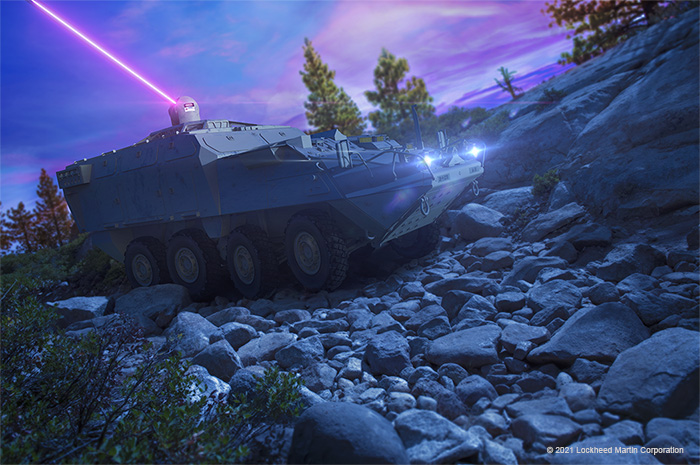
Lockheed Martin is developing the DEIMOS laser weapon system for a future Army competition. (Lockheed Martin)
WASHINGTON: Lockheed Martin is building a new laser weapon for Stryker combat vehicles in anticipation for a future competition for the US Army’s short range air defense system, the company announced Monday.
Lockheed is designing a 50 kilowatt laser called DEIMOS, short for Directed Energy Interceptor for Maneuver of Short Range Air Defense, said Tyler Griffin, Lockheed’s director of laser and sensor systems.
“We see a competition for a program of record on the horizon. The [Army’s Rapid Capabilities and Critical Technologies Office] and [Program Executive Office] Missiles and Space have been very clear about that,” he said, adding that the competition could occur as early as 2023.
Lockheed hopes to unseat an incumbent team of Raytheon and Kord Technologies, which received a $123.9 million contract this summer to build a Directed Energy Maneuver Short Range Air Defense system (DE M-SHORAD) from the Army after their prototype completed a shoot out earlier this year.
Under that contract, the companies are tasked to build three additional laser systems that will be integrated onboard Stryker vehicles — enough for the Army to field its first platoon of four laser-equipped Strykers. Raytheon is developing the 50 kilowatt laser, while Kord is the systems integrator and developing the power management and cooling system.
When the RCCTO hands off threshold requirements and technical data to PEO Missiles in Space in FY23, Lockheed executives believe the Army will open up another round of competition, Griffin said.
Lockheed intends to differentiate DEIMOS with an emphasis on affordability — not just the price of the system, but the cost-per-kill and maintenance of the system, Griffin said.
“What we’re looking at, from a Lockheed Martin perspective, is looking for best of breed technologies, many of which we can reuse from [other Lockheed laser technology programs],” he said. “But also extending that into Army radar components and, in the end, having an optimal combination of schedule, affordability, and low risk throughout the entire lifecycle.”
Lockheed plans to builds a “digital twin” of DEIMOS that will act as an exact virtual replica of the system, allowing for modifications and improvements of the system to be developed and tested more quickly.
Its work on other directed energy programs — such as the Indirect Fires Protection Capability – High Energy Laser it’s building with Dynetics for the Army — could also give the company an advantage in managing the size, weight, power and cooling of the system.
Lockheed aims to have development of the DEIMOS digital twin finished by the end of 2021 and begin field demonstrations by the end of 2022, Griffin said.
Besides Raytheon, Lockheed could also face off with Northrop Grumman for a future DE M-SHORAD contract.
Northrop was competing against Raytheon for the RCCT effort but withdrew from the shootout after its directed energy system malfunctioned multiple times during tests, at once point breaking into a fire that damaged the laser and other hardware, Defense News reported in August.
25 Oct 2021
SAN DIEGO
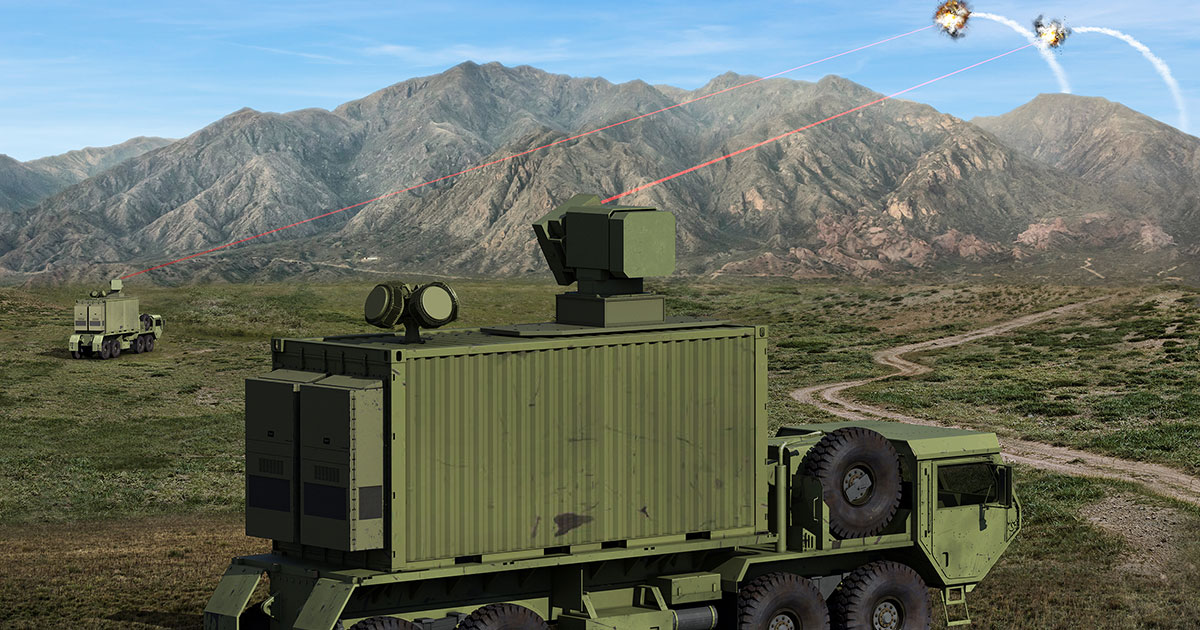
A General Atomics Electromagnetic Systems (GA-EMS) and Boeing [NYSE: BA] team has been awarded a U.S. Army Rapid Capabilities and Critical Technologies Office (RCCTO) contract to develop a 300kW-class solid state Distributed Gain High Energy Laser Weapon System. Delivery will be a 300 kW-class distributed gain laser with an integrated Boeing beam director. The objective of this contract is a demonstration of the design.
“The high power, compact laser weapon subsystem prototype that GA-EMS will deliver under this contract will produce a lethal output greater than anything fielded to date,” said Scott Forney, president of GA-EMS. “This technology represents a leap-ahead capability for air and missile defense that is necessary to support the Army’s modernization efforts and defeat next-generation threats in a multi-domain battlespace.”
The partnership combines both companies’ expertise in Directed Energy to deliver best-in-class, combat-ready protection for the warfighter with unmatched speed, performance, safety and affordability. Specifically, the system will leverage GA-EMS’ scalable Distributed Gain Laser technology with Boeing’s beam director and precision acquisition, tracking and pointing software to provide a complete demonstrator with sophisticated laser and beam control.
Dr. Michael Perry, vice president for lasers and advanced sensors at GA-EMS describes the laser as “a packaged version of the 7th Generation of our Distributed Gain Design already demonstrated. The laser system employs two Gen 7 laser heads in a very compact and lightweight package. Recent architectural improvements have enabled our single-beam DG Lasers to achieve comparable beam quality to fiber lasers in a very simple design without the need for beam combination,”
“We’re excited to take the next step in delivering this critical capability to the Army,” said Cindy Gruensfelder, vice president and general manager of Boeing’s Missile and Weapon Systems division. “Our joint offering will leverage proven, deployed technologies to provide an industry-leading solution on an accelerated timeline.”
Last edited:
